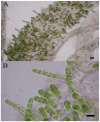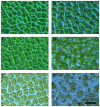A strategy for the proliferation of Ulva prolifera, main causative species of green tides, with formation of sporangia by fragmentation
- PMID: 20052408
- PMCID: PMC2797376
- DOI: 10.1371/journal.pone.0008571
A strategy for the proliferation of Ulva prolifera, main causative species of green tides, with formation of sporangia by fragmentation
Abstract
Ulva prolifera, a common green seaweed, is one of the causative species of green tides that occurred frequently along the shores of Qingdao in 2008 and had detrimental effects on the preparations for the 2008 Beijing Olympic Games sailing competition, since more than 30 percent of the area of the games was invaded. In view of the rapid accumulation of the vast biomass of floating U. prolifera in green tides, we investigated the formation of sporangia in disks of different diameters excised from U. prolifera, changes of the photosynthetic properties of cells during sporangia formation, and development of spores. The results suggested that disks less than 1.00 mm in diameter were optimal for the formation of sporangia, but there was a small amount of spore release in these. The highest percentage of area of spore release occurred in disks that were 2.50 mm in diameter. In contrast, sporangia were formed only at the cut edges of larger disks (3.00 mm, 3.50 mm, and 4.00 mm in diameter). Additionally, the majority of spores liberated from the disks appeared vigorous and developed successfully into new individuals. These results implied that fragments of the appropriate size from the U. prolifera thalli broken by a variety of factors via producing spores gave rise to the rapid proliferation of the seaweed under field conditions, which may be one of the most important factors to the rapid accumulation of the vast biomass of U. prolifera in the green tide that occurred in Qingdao, 2008.
Conflict of interest statement
Figures







References
-
- Schories D, Reise K. Germination and anchorage of Enteromorpha sp. in sediments of the Wadden Sea. Helgoländer Meeresunter. 1993;47:275–285.
-
- Fletcher RL. The occurrence of ‘green tides’: a review. In: Schramm W, Nienhuis PH, editors. Marine benthic vegetation: recent changes and the effects of eutrophication. Berlin: Springer; 1996. pp. 7–43.
-
- Poole LJ, Raven JA. The biology of Enteromorpha. Progress in Phycological Research. 1997;12:1–148.
-
- Valiela I, Mcclelland J, Hauxwell J, Behr PJ, Hersh D, et al. Macroalgal blooms in shallow estuaries: controls and ecophysiological and ecosystem consequences. Limnology and Oceanography. 1997;42:1105–1118.
-
- Blomster J, Bäck S, Fewer DP, Kiirikki M, Lehvo A, et al. Novel morphology in Enteromorpha (Ulvophyceae) forming green tides. American Journal of Botany. 2002;89:1756–1763. - PubMed
Publication types
MeSH terms
LinkOut - more resources
Full Text Sources
Other Literature Sources

